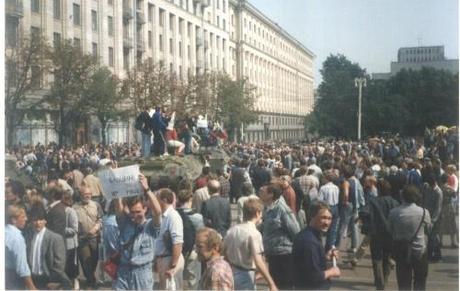
Demonstration in the streets of Moscow during the 1991 coup d’état attempt. Photo credit Wikimedia Commons via www.newint.org
For anyone who watches the countries of the former Soviet Union, this last month has offered a tempting array of articles pegged to the events of 20 years ago. On August 19, 1991, a hard-line group of top Soviet officials staged a putsch while Soviet leader Mikhail Gorbachev was on vacation. The poorly organized putsch quickly failed, largely as a result of the courage of Boris Yeltsin and his pro-democracy supporters. The putsch is significant today because it was one of a key series of events that led to the December 1991 collapse of the Soviet Union and the emergence of 15 new sovereign states.
Coverage of the 20th anniversary offers a handy report card on a vast area that is less and less often treated as a unit. Much of the analysis includes factual examinations of the relative levels of health, wealth and freedom in the Soviet Union’s 15 successor states.
One of the most useful is a web presentation by the BBC that shows the prosperous Baltic country of Estonia on one end of the spectrum and the near-failed Central Asian state of Tajikistan on the other. Perhaps the most thoughtful and comprehensive treatment of the anniversary can be found in Foreign Policy magazine, which devoted much of one issue to the topic.
Elsewhere, some commentators use the two-decade mark to question the usefulness of the term “former Soviet Union” for understanding the vast region in any way other than historical. One essay in particular in RFE/RL captures the way in which the political and economic policies of the European Union, Turkey and China have created new allegiances that frequently have more significance than traditional ties between the 15 countries.
An overarching theme to nearly all the coverage is the contrast between the promise of those few days in August 1991 – as embodied in the iconic image of Yeltsin astride a tank sent by the putsch leaders – with the deep economic and political disappointments that have followed in all the former Soviet countries, except the three Baltic nations of Lithuania, Estonia and Latvia. Based on Freedom House’s annual survey of world freedom, the remaining 12 countries are either “partly free” (three countries) or “not free” (nine countries).
In an essay devoted to the 20th anniversary, Freedom House argues that the region as a whole is increasingly authoritarian, partly because of the example set by Russian prime minister Vladimir Putin’s successful consolidation of power since 2000. A striking Freedom House graphic captures the ossification in top leadership in countries such as Azerbaijan, where father handed off to son, or Kazakhstan and Uzbekistan, where the people are lead by the same man they started with in 1991.
In general, the anniversary coverage in the Western press tends to take a big picture approach or consist of personal recollections, as did a recent op-ed piece by Gorbachev in the Washington Post.
What has largely been missing is a taking stock of what has happened in the spaces between the macro and the individual. CIPE’s experience in the region offers some insight. In Russia especially, CIPE focuses on regional efforts to fight corruption and bring about economic reform. Working through democratic institutions, groups representing entrepreneurs seek to bring about the kind of local changes that could prove key to Russia’s eventual realization of its democratic potential. In Moldova and Kyrgyzstan, too, regional associations of businesses find a voice on national policy through CIPE efforts. In all the countries of the former Soviet Union, they are approaches that, for a host of reasons, were unimaginable 20 years ago.

